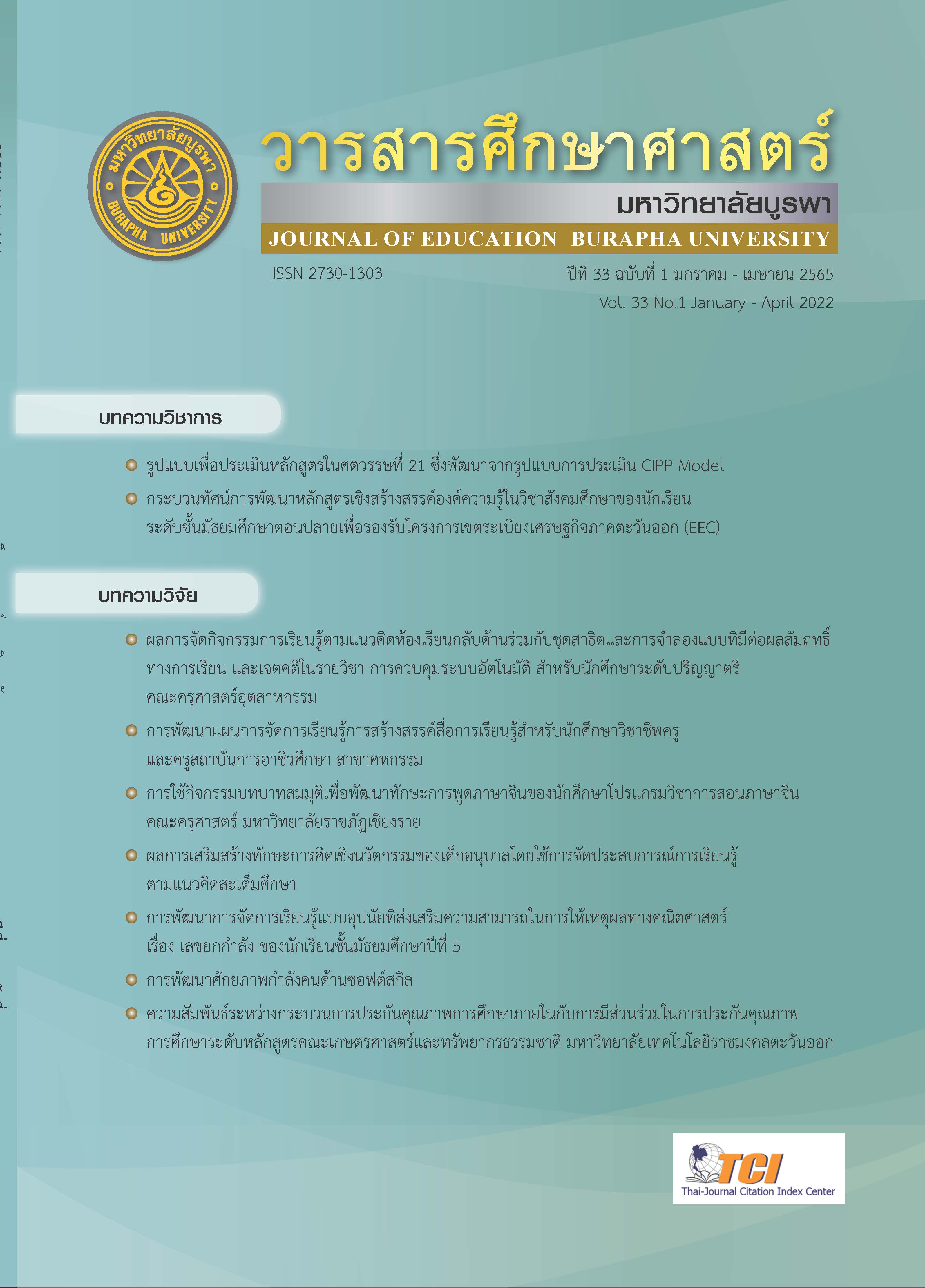DEVELOPMENT OF LESSON PLANS FOR CREATE LEARNING MEDIA FOR PRE-SERVICE TEACHERS AND HOME ECONOMICS TEACHERS OF A VOCATIONAL EDUCATION INSTITUTION
Keywords:
create learning media, learning media in home economics education, vocational education teachersAbstract
This study aimed to 1) create lesson plans and learning media for three master courses, and 2) develop lesson plans for create learning media for pre-service teachers and home economics teachers working under the Office of the Vocational Education Commission. The samples based on voluntary selection consisted of 20 home economics teachers employed by the Office of Vocational Education Commission and 30 fifth-year students majoring in home economics Education at Rajamangala University of Technology Krungthep. The research tools as 1) learning plan and learning media for the prototype course 2) learning plan for creative learning media 3) a self-guided learning assessment form 4) a behavioral assessment form 5) a performance evaluation form and 6. ) Activity Satisfaction Assessment Form The findings showed that: 1) The evaluations of the 3 master courses: Garland Making Course, Authentic Thai Cuisine and Gifts and Souvenirs showed extremely positive. All three courses' master lesson plans and learning media (E1/E2) were evaluated and scored as being more effective than the effectiveness criteria of 80/80. 2) The lesson plans for developing skills to create learning media for pre-service teachers and home economics teachers working under the Office of the Vocational Education Commission consist of 2 lesson plans. The quality of the lesson plans was assessed and received a very good rating score (M=4.46, S.D.=0.44). The result of the lesson plan implementation revealed that self-evaluation of ability to self-directed learning received a high average score (M=3.84, S.D.=0.53). In terms of satisfaction with the photography activity, the overall assessment score was found to be very good (80.10%). Moreover, the overall satisfaction of the project participants with the activities to develop skills to create learning media received the highest score (M=4.76, S.D.=0.95).
References
กระทรวงศึกษาธิการ. (2558) นโยบายด้านการอาชีวศึกษา. [สืบค้นเมื่อวันที่ 20 กันยายน 2562] จาก https://www.vec.go.th/Portals/0/Doc/vecit.pdf
กลุ่มเทคโนโลยีสารสนเทศเพื่อการบริหารงานอาชีวศึกษา. (2564). จำนวนนักเรียนภาครัฐและเอกชนรายประเภทวิชาปีการศึกษา 2560-2564. เข้าถึงจาก. https://techno.vec.go.th/
ดุสิต ขาวเหลือง และ อภิชาติ อนุกูลเวช. (2562). การพัฒนาสื่อการเรียนรู้สามมิติแบบมีปฏิสัมพันธ์เสมือนจริงโดยใช้เทคโนโลยีความเป็นจริงเสริม เพื่อพัฒนาทักษะการคิดอย่างมีวิจารณญาณของนักศึกษาอาชีวศึกษาที่มีระดับการคิดอย่างมีวิจารณญาณต่างกัน. วารสารศึกษาศาสตร์ 30 (3), 16 - 29.
นนทลี พรธาดาวิทย์. (2545) วิถีคหกรรมศาสตร์ในประเทศไทย : บทสะท้อนวิสัยทัศน์และกระบวนทัศน์ จากปัจจุบันสู่อนาคต. มหาวิทยาลัยเกษตรศาสตร์.กรุงเทพฯ.
ภัทราดา เอี่ยมบุญญฤทธิ์. (2564). การพัฒนาชุดการสอนแบบ Active learning โดยใช้เทคนิค SQ3R เพื่อเสริมสร้างทักษะการอ่านจับใจความสำหรับนักเรียนชั้นประถมศึกษาปีที่ 3 โรงเรียนสาธิต “พิบูลบำเพ็ญ” มหาวิทยาลัยบูรพา.วารสารศึกษาศาสตร์ มหาวิทยาลัยบูรพา. 32 (1), 77- 88.
วไลภรณ์ สุทธา และ วิกร ตัณฑวุฑโฒ. (2558). การพัฒนาแบบจำลองการเรียนการสอนคหกรรมศาสตร์โดยใช้การเรียนแบบผสมผสาน สำหรับนักศึกษามหาวิทยาลัยเทคโนโลยีราชมงคล. วารสารวิชาการและวิจัย มทร.พระนคร. 9(2), 114-128.
วิจารณ์ พานิช (2555). วิถีสร้างการเรียนรู้เพื่อศิษย์ในศตวรรษที่ 21. กรุงเทพฯ: มูลนิธิสดศรี-สฤษดิ์วงศ์.
สยุมพร ศรีมุงคุณ. (2554). ทฤษฎีเกี่ยวกับการเรียนรู้.[สืบค้นเมื่อวันที่ 25 กรกฏาคม 2564] จาก https://www.gotoknow.org/posts/341272.
สํานักงานคณะกรรมการการอาชีวศึกษา. (2561). กระทรวงศึกษาธิการแผนพัฒนาการอาชีวศึกษา พ.ศ. 2560-2579. [สืบค้นเมื่อวันที่ 25 กันยายน 2563] จาก https://www.vec.go.th/
Ayse Gul Kara Aydemir & Gulfidan Can,. (2019). Educational technology research trends in Turkey from a critical perspective: An analysis of postgraduate theses. British Journal of Educational Technology. 50 (3), 1087-1103.
Bochkareva, T. N. et al. (2020). The Analysis of Using Active Learning Technology in Institutions of Secondary Vocational Education. International Journal of Instruction. 13 (3), 371-386.
Center For Teaching Innovation (2 5 6 2) [Online], Available: http://www.cte.cornell.edu (2020, 20 January).
Gifkins, J. (2015). What Is ‘Active Learning’ and Why Is It Important? E-internationalrelations. [Online], Available: http://www.eir.info/2 0 1 5 / 1 0 / 0 8 / what-is-activelearning-and-why-is-it-important. (2020, 23 January).
H. Thomas, et al. (2021). "Self-Supervised Learning of Lidar Segmentation for Autonomous Indoor Navigation," 2021 IEEE International Conference on Robotics and Automation (ICRA), 2021, pp. 14047-14053.
José Gómez-Galán et al. (2020). Measurement of the MOOC Phenomenon by Pre-Service Teachers: A Descriptive Case Study. Education Science 2020, 10, 215 [Online], Available https://www.mdpi.com/journal/education.
Oh, Kyungseon & Lee, Soo-Hee. (2021). Application of Home Economics Teaching-Learning Plan in the Clothing For Teenager’s Empowerment. Journal of Korean Home Economics Education Association. 33 (1), 169-184.
Downloads
Published
Issue
Section
License

This work is licensed under a Creative Commons Attribution-NonCommercial-NoDerivatives 4.0 International License.
บทความทุกบทความเป็นลิขสิทธิ์ของวารสารศึกษาศาสตร์ มหาวิทยาลัยบูรพา


